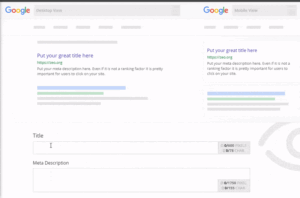Top 10 free SEO tools for beginners
As a beginner in the world of Search Engine Optimization (SEO), navigating the vast array of tools and techniques can be overwhelming. However, with the right free SEO tools, you can set your website up for success without breaking the bank. In this article, we’ll explore the top 10 free SEO tools every beginner should know.
Why Free SEO Tools Matter for Beginners
Free SEO tools provide valuable insights into your website’s performance, helping you identify areas for improvement. They also offer a cost-effective way to start SEO optimization, allowing you to scale up as your website grows.
Top 10 Free SEO Tools for Beginners
1. Google Analytics:
Google Analytics is a powerful tool for tracking website performance. It provides valuable insights into traffic, engagement, and conversion rates. It helps website owners understand their audience demographics, interests, and behavior, enabling data-driven decisions.
Features:
- Track website traffic and engagement
- Analyze audience demographics and interests
- Monitor conversion rates and goal completion
- Set up tracking and goal-tracking
- Limitations: Requires setup and tracking code installation
- Use: Optimize website content and marketing strategies
2. Google Search Console:
Google Search Console (GSC) is a free SEO tool that empowers website owners to monitor and optimize their online presence. This platform provides invaluable insights into search engine rankings, impressions, clicks, and crawl errors, enabling data-driven decisions. With GSC, you can:
- Submit sitemaps and ensure search engine crawlability
- Identify keyword opportunities and optimize content
- Monitor website performance and fix technical SEO issues
- Verify website ownership and manage search engine visibility
- Analyze competitor websites and refine marketing strategies
Features:
- Monitor search engine rankings and impressions
- Identify crawl errors and issues
- Verify website ownership
- Submit sitemaps
Limitations: Requires verification and setup
Use: Improve search engine optimization and visibility
3. Ahrefs (Free Version):
Ahrefs is a comprehensive free SEO tool that offers a wealth of insights to enhance your website’s online presence. With its free version, you can analyze backlinks, identify keyword opportunities, and evaluate content quality. Ahrefs’ free SEO tool provides:
Backlink analysis: Understand your website’s link profile
Keyword Research: Find relevant keywords and phrases
Content Analysis: Evaluate content quality and relevance
SEO Audit: Identify technical SEO issues
As a free SEO tool, Ahrefs is an essential resource for website owners, digital marketers, and SEO enthusiasts. Its robust features and accurate data make it an ideal choice for optimizing your website and improving search engine rankings.
Features:
- Analyze backlinks and anchor text
- Identify keyword opportunities
- Evaluate content quality and relevance
- Limited to 50 queries per month
Limitations: Limited features compared to paid version
Use: Optimize content and build backlinks
4. SEMrush (Free Version):
SEMrush is a powerful free SEO tool that helps website owners and digital marketers optimize their online presence. With its free version, you can identify technical SEO issues, track keyword rankings, and analyze competitor websites.
Features:
- Identify technical SEO issues
- Track keyword rankings
- Analyze competitor websites
- Limited to 10 queries per day
Limitations: Limited features compared to paid version
Use: Improve technical SEO and competitor analysis
As a leading free SEO tool, SEMrush empowers users to improve website visibility, drive more traffic, and enhance search engine optimization. Its user-friendly interface and accurate data make it an indispensable resource for SEO success.
5. Moz Keyword Explorer (Free Version):
Moz is a renowned free SEO tool that equips website owners and digital marketers with actionable insights to enhance their online presence. Moz’s free SEO tool, Keyword Explorer, offers:
Keyword Research: Find relevant keywords and phrases
Competitor Analysis: Analyze rival websites and strategies
SEO Audit: Identify technical SEO issues and opportunities
Content Optimization: Optimize content for target keywords
Moz Keyword Explorer’s free version finds relevant keywords and phrases.
Features:
- Find relevant keywords and phrases
- Analyze keyword difficulty
- Identify keyword opportunities
- Limited to 10 queries per month
Limitations: Limited features compared to paid version
Use: Optimize content for target keywords
6. Ubersuggest:
As a popular free SEO tool, Ubersuggest provides users with valuable insights to improve website visibility, drive more traffic, and boost search engine rankings. With its user-friendly interface and comprehensive data, Ubersuggest’s free SEO tool is perfect for beginners and experts alike, helping you refine your SEO strategy and stay ahead of the competition.
Features:
- Generate keyword ideas
- Get content suggestions
- Analyze competitor websites
- Unlimited queries
Limitations: Limited features compared to paid version
Use: Identify keyword opportunities and optimize content
7. Google Trends:
Google Trends is a powerful free SEO tool that helps website owners and digital marketers stay ahead of the curve by identifying popular search terms, topics, and trends. With Google Trends’ free SEO tool, you can:
Analyze Search Volume: Understand keyword popularity and trends
Compare Search Terms: Identify relevant keywords and phrases
Geographic Analysis: Understand search patterns across regions
Related Topics: Discover trending topics and ideas
Features:
- Analyze search volume and trends
- Identify geographic distribution
- Compare search terms
- Unlimited queries
Limitations: Limited to search volume data
Use: Identify popular topics and trends
8. Keyword Tool:
Keyword Tool is a versatile free SEO tool that helps website owners and digital marketers discover profitable keywords, phrases, and long-tail keywords. As a reliable free SEO tool, Keyword Tool provides valuable insights to optimize your content, improve website visibility, and drive more traffic. By leveraging the Keyword Tool, you can refine your SEO strategy, identify untapped keywords, and outperform competitors.
Features:
- Find long-tail keywords
- Identify keyword questions
- Analyze keyword difficulty
- Unlimited queries
Limitations: Limited features compared to paid version
Use: Optimize content for target keywords
9. SEOquake:
As a trusted free SEO tool, SEO Quake provides actionable insights to enhance website visibility, drive more traffic, and boost search engine rankings. By leveraging SEO Quake, you can refine your SEO strategy, identify technical issues, and outperform competitors.
SEO Quake is a free SEO tool that helps website owners and digital marketers optimize their online presence with precision. With SEO Quake’s free SEO tool, you can:
Audit Website Technical SEO: Identify and fix issues
Analyze Keyword Density: Optimize content for target keywords
Assess Website Performance: Improve loading speed and usability
Research Competitors: Uncover rival strategies and strengths
SEOquake audits website technical SEO, performance, and structure.
Features:
- Audit website technical SEO
- Analyze website performance
- Identify structure issues
- Unlimited queries
Limitations: Limited features compared to paid version
Use: Improve technical SEO
10. Screaming Frog (Free Version):
Screaming Frog is a powerful free SEO tool that helps website owners and digital marketers crawl, analyze, and optimize their websites for better search engine rankings. With Screaming Frog’s free SEO tool, you can:
- Identify technical SEO issues and opportunities
- Analyze page titles, meta descriptions, and headers
- Find broken links and redirect issues
- Optimize website structure and internal linking
As a trusted free SEO tool, Screaming Frog provides valuable insights to enhance website visibility, drive more traffic, and boost search engine rankings. Its free version allows users to crawl up to 500 URLs, making it an ideal solution for small to medium-sized websites.
Screaming Frog’s free version crawls and analyzes website structure.
Features:
- Crawl and analyze website structure
- Identify technical SEO issues
- Analyze website performance
- Limited to 500 URLs
Limitations: Limited features compared to paid version
Use: Improve technical SEO and website structure
Conclusion:
These 10 free SEO tools provide a solid foundation for beginners to improve their website’s visibility and ranking. By leveraging these tools, you’ll gain valuable insights into your website’s performance and make data-driven decisions to drive growth.
Bing: Microsoft’s Powerful Search Engine
Imagine a search engine that not only finds what you need but understands exactly what you’re asking for. In 2025, Bing will continue to be a powerful search engine driven by advanced AI technology. Microsoft’s integration of OpenAI’s tech into Bing, particularly its use of GPT models, has positioned it as a strong competitor to Google. This AI-powered search engine now offers more intuitive, personalized search results and capabilities like natural language processing and content creation features, enhancing the user experience.
Bing’s generative AI has delivered detailed answers and performed complex tasks directly within the search interface. This innovative approach has made Bing an increasingly popular choice for users seeking more than just simple search results.
Top 10 Features of Bing

Here’s a list of the top 20 features of Bing that are making a significant impact in the market:
1. AI-Powered Search:
Bing’s AI-Powered Search feature significantly enhances the search experience by leveraging advanced technologies such as machine learning and natural language processing. This integration allows Bing to provide more relevant and personalized results, understanding user queries in context rather than merely matching keywords.
- Enhanced Relevance: AI analyzes extensive datasets to understand user intent, delivering results that are more aligned with what users are truly looking for .
- Natural Language Processing: Users can phrase their queries in natural language, making searches more intuitive and conversational. This approach allows Bing to interpret and respond to complex questions effectively .
- Generative AI Capabilities: Bing employs generative AI to provide users with direct answers and summaries, enhancing the speed and efficiency of information retrieval .
- User Engagement: The AI-driven features aim to improve user engagement by tailoring content and suggestions based on previous interactions .
2. Chat Functionality:
Bing’s Chat Functionality represents a significant advancement in how users interact with search engines. This feature allows users to engage in a conversational manner, making the search experience more intuitive and efficient. Here’s a closer look at its key aspects and benefits:
- Conversational Interface: Users can type or speak their queries as if they were having a dialogue with a human. This natural language processing capability makes it easier for users to express complex questions or requests without needing to use specific keywords.
- Contextual Understanding: The chat functionality can understand the context of previous queries, allowing for follow-up questions and a more seamless search experience. This context-awareness helps tailor responses more accurately to user needs.
- Detailed Responses: Unlike traditional search engines that typically provide a list of links, Bing’s chat feature offers direct answers and explanations. Users can receive comprehensive information on a topic in a single interaction.
- Interactive Learning: Users can ask clarifying questions, delve deeper into topics, or explore related subjects—all within the same chat. This interactive approach encourages exploration and learning.
- Integrated Services: Bing’s chat can integrate with other Microsoft services, allowing users to perform tasks like scheduling, finding directions, or even creating documents directly from the chat interface.
3. Image and Video Search:

Bing has made significant advancements in its Image and Video Search capabilities, enhancing the way users find and interact with visual content online. Here’s a closer look at this feature:
Key Aspects of Bing’s Image and Video Search
Here’s a table summarizing the key aspects of Bing’s Image and Video Search capabilities:
| Key Aspect | Description |
|---|---|
| Enhanced Search Algorithms | Employs advanced algorithms to deliver relevant image and video results based on user queries, analyzing search context for precise matches. |
| High-Quality Content | Focuses on curating high-quality images and videos from a wide array of sources, ensuring visually appealing and relevant content. |
| Visual Search Functionality | Allows users to perform visual searches by uploading images directly, helping locate similar images or identify objects within a photo. |
| Filtering Options | Provides various filtering options to refine search results, allowing users to filter by size, color, type (e.g., clipart, photographs), and layout. |
| Video Previews | Offers thumbnail previews for videos, enabling users to view short snippets of content before deciding to click through for the full video. |
| Attribution and Licensing Info | Displays clear licensing information for images, making it easier for users to understand legal usage, beneficial for content creators and marketers. |
| Integration with Other Services | Integrated with Microsoft services like Office and OneDrive, enhancing productivity for users working with visual content. |
| Responsive Design | Optimized for various devices, providing a seamless experience on desktops, tablets, and smartphones. |
| Trending Visual Content | Highlights trending images and videos, providing insights into popular content and helping users discover new information relevant to current events. |
| User-Friendly Interface | Presents search results in a visually appealing grid format, facilitating easy scrolling and selection of desired content. |
This table provides a concise overview of the features and functionalities that enhance user experience in Bing’s Image and Video Search.
4. Visual Search:
Bing’s Visual Search feature revolutionizes the way users interact with search engines by allowing them to use images instead of text-based queries. This capability offers numerous practical applications, enhancing user experience and improving search efficiency. Here are different ways in which Bing’s Visual Search is utilized:
1. Image Upload for Search
- How it Works: Users can upload a photo or screenshot directly to Bing to find similar images, products, or locations. This eliminates the need for text descriptions and streamlines the search process.
- Use Case: If you spot a piece of clothing online but don’t know where to buy it, you can upload the image to Bing, which will find retailers offering that item.
2. Search by Camera
- How it Works: Through mobile devices, users can take pictures of objects or landmarks and use them to initiate a search. This real-time capability leverages the device’s camera and Bing’s AI technology. While traveling, a user can point their phone at a historical landmark to learn more about its history, significance, and visiting hours.
3. Product Recognition
- How it Works: Visual Search can recognize products in images, linking users to online retailers or similar products. Users can take a photo of a product they wish to purchase, and Bing will provide links to sites selling that product or alternatives.
4. Plant and Animal Identification
- How it Works: Users can upload photos of plants or animals, and Bing can identify them based on its extensive database. Nature enthusiasts can take pictures of unknown flora or fauna, instantly learning about the species and its habitat.
5. Home Decor and Interior Design
- How it Works: Users can snap a picture of a room or decor item, and Bing will suggest similar items or design ideas.
- Use Case: Someone wanting to redecorate their living space can upload images of furniture and get inspiration or links to where they can purchase similar pieces.
6. Food Recognition
- How it Works: Users can photograph dishes or ingredients to get recipes or nutritional information. A person unsure about a dish they encounter at a restaurant can upload an image to find out what it is and how to prepare it.
7. Fashion and Style Assistance
- How it Works: Users can upload outfit photos to discover similar styles, brands, or accessories.
- Use Case: Shoppers can get outfit ideas or find accessories that match their existing clothing items.
8. Visual Search in Shopping
- How it Works: When browsing e-commerce sites, users can use Visual Search to find items based on images seen elsewhere.
- Use Case: If a user sees a stylish outfit on social media, they can use Bing’s Visual Search to locate it online quickly.
5. Integrated Microsoft Office:

Here’s a detailed overview of the Integrated Microsoft Office feature in Bing, along with a diagram to illustrate its functionality.
Integrated Microsoft Office in Bing
Definition:
The integration of Microsoft Office with Bing allows users to seamlessly access and manage Office applications such as Word, Excel, PowerPoint, and OneNote directly from the Bing search engine. This feature enhances productivity by enabling users to create, edit, and share documents without switching between applications or browsers.
- Accessibility: Users can easily open and create documents from Bing, improving efficiency and reducing the need to navigate through multiple interfaces.
- Real-Time Collaboration: Integrated features enable multiple users to collaborate on documents in real-time, making teamwork more efficient.
- Cloud Storage: Documents created or edited through Bing are automatically saved to OneDrive, ensuring that users can access their files from anywhere.
- Enhanced Search: Bing’s search capabilities can be utilized to find relevant content and data to incorporate into Office documents seamlessly.
- Template Availability: Users can quickly access templates for various Office applications directly from Bing, saving time on document formatting.
Diagram: Integrated Microsoft Office Feature in Bing
Here’s a simple diagram to illustrate how the integration works:
+-------------------+
| Bing Search |
+-------------------+
|
+-----------------+-----------------+
| | |
+---------------+ +---------------+ +---------------+
| Word | | Excel | | PowerPoint |
+---------------+ +---------------+ +---------------+
| | |
+-----------------+-----------------+
|
+-------------------+
| OneDrive |
+-------------------+6. Bing Maps:

Bing Maps is a powerful mapping service developed by Microsoft, offering users a range of features designed to enhance navigation, exploration, and local search capabilities. It integrates various technologies to provide accurate, real-time information, making it an essential tool for individuals and businesses alike.
Key Features of Bing Maps
- Detailed Mapping: Bing Maps provides high-resolution satellite imagery and detailed street maps, allowing users to zoom in and explore areas in great detail.
- Traffic Information: Real-time traffic updates help users avoid congested routes and make informed decisions about their travel. Users can see traffic conditions on their route and adjust their travel plans accordingly.
- Road and Transit Directions: The service offers step-by-step driving directions, public transit routes, and even biking and walking directions, catering to a variety of travel preferences.
- Bird’s Eye View: This unique feature offers a 3D perspective of the area, giving users a more immersive view of landscapes, buildings, and geographical features.
- Local Business Listings: Bing Maps provides information on local businesses, including reviews, contact details, and hours of operation, making it easier for users to find services nearby.
- Integration with Other Microsoft Services: Bing Maps seamlessly integrates with Microsoft products, such as Outlook and Windows, allowing users to access maps directly from their email or calendar events.
Example :
Imagine you’re planning a weekend trip to San Francisco. You want to explore popular attractions like the Golden Gate Bridge, Alcatraz Island, and Fisherman’s Wharf. Here’s how you can use Bing Maps for your trip:
- Search for Attractions: Open Bing Maps and type “Golden Gate Bridge” in the search bar. The map will display the location, along with a detailed view of the surrounding area.
- Get Directions: Click on “Directions” to input your starting location. Bing Maps will provide driving directions to the Golden Gate Bridge, including estimated travel time and current traffic conditions.
- Explore Nearby Locations: While at the Golden Gate Bridge, you can use Bing Maps to find nearby attractions, restaurants, and hotels. For instance, searching for “restaurants near Golden Gate Bridge” will display a list of dining options with ratings and reviews.
- Traffic Updates: On your way to Fisherman’s Wharf, you can check Bing Maps for real-time traffic updates to avoid any delays.
- Bird’s Eye View: Use the Bird’s Eye View feature to see a 3D representation of Alcatraz Island, giving you a better sense of its layout before your visit.
By utilizing Bing Maps, you can enhance your travel experience with efficient planning, real-time information, and a wealth of local knowledge at your fingertips. This makes it an invaluable resource for travelers and locals alike.
7. Local Business Information:
Local Business Information in Bing refers to the details and data that help users find and connect with local businesses through the Bing search engine and Bing Maps. This information typically includes:

- Business Name: The official name of the business as it appears in the real world.
- Address: The physical location of the business, essential for customers looking to visit.
- Phone Number: Contact details for customers to reach out directly.
- Business Hours: Information about when the business is open for customers.
- Website URL: A link to the business’s official website for more information.
- Categories: The type of services or products offered by the business, which helps in classification and searchability.
- Customer Reviews: Feedback from past customers, often influencing potential customers’ decisions.
- Images and Videos: Visual content showcasing the business and its offerings.
Providing accurate and comprehensive Local Business Information on Bing helps improve visibility in local search results, attracting more customers and enhancing overall local SEO efforts
8. Voice Search:
Bing’s Voice Search feature allows users to interact with the search engine using spoken queries instead of typing. This feature enhances user convenience and accessibility, particularly for those on mobile devices or using voice-activated technology.
Key Features of Bing Voice Search
| Feature | Description |
|---|---|
| Voice Input | Users can ask questions using natural language, and Bing converts the speech into text. |
| Search Accuracy | Powered by advanced speech recognition technology, Bing’s voice search delivers accurate results . |
| Contextual Awareness | Bing understands the context of queries, providing relevant answers based on previous interactions and current trends . |
| Integration | Voice search is integrated into Bing and works seamlessly with Microsoft products, enhancing the overall user experience . |
Example :
A user might say, “What’s the weather like in New York today?” Bing will process this voice input, convert it into text, and return relevant weather information, providing a quick and hands-free search experience.
This feature exemplifies Bing’s commitment to improving user interaction through voice technology, making it a competitive choice for users seeking a more intuitive search experience
9.Privacy Controls:
Bing’s Privacy Controls are designed to give users more transparency and control over their personal data while using the search engine. Here’s how this feature works:
- Data Management: Users can access settings to manage their personal information that Bing collects. This includes the ability to review what data is stored and how it is used.
- Personalization Options: Bing allows users to customize their search experience by enabling or disabling personalized search results based on their search history and interactions.
- Ad Preferences: Users can control the types of ads they see by managing their ad preferences. This allows users to opt out of personalized ads or adjust their settings based on their interests.
- Clear Search History: Users can easily clear their search history from their account, providing a way to maintain privacy regarding past searches.
- Increased Transparency: Bing provides information on how it uses collected data, helping users understand the implications of their privacy choices.
These privacy controls are aimed at enhancing user trust and ensuring a safer browsing experience, particularly in a digital landscape where data privacy is increasingly important .
Conclusion:
In conclusion, Bing offers a robust and user-friendly search experience, emphasizing privacy controls, innovative features like Bing Maps, and personalized content that caters to user needs. As the digital landscape evolves, utilizing Bing’s advanced search capabilities can significantly enhance your online experience, whether you are looking for information, images, or local businesses.
To stay updated on the latest features and maximize your search potential, we invite you to visit our website for expert insights, tips, and resources that will help you navigate the digital world effectively. Explore now and take your first step towards harnessing the full power of Bing!
Unlocking the Power of Google Search Engine: A Comprehensive Guide for 2025″
In the digital age, search engines have revolutionized the way we access information. Google, the most widely used search engine, processes over 40,000 search queries every second. Understanding how Google works is crucial for businesses, marketers, and individuals seeking online visibility. In this article, we’ll delve into the intricacies of Google’s search engine, exploring its algorithm, features, and ranking factors.
What is Google Search Engine?
Google search engine is a complex software system that retrieves and ranks relevant information from the internet. Its primary function is to provide accurate and helpful results for users.

How Google Search Engine Works
Google’s search process involves:
- Crawling: Google’s bots scan and index web pages.
- Indexing: Google stores crawled pages in its massive database.
- Retrieval: Google fetches relevant pages for search queries.
- Ranking: Google orders retrieved pages by relevance and authority.
Google Algorithm: The Brain Behind the Search
Google’s algorithm is a sophisticated system that evaluates web pages based on:
- PageRank: Evaluates page importance based on links.
- Panda: Focuses on content quality and user experience.
- Penguin: Targets spammy links and manipulative tactics.
- Hummingbird: Improves natural language processing.
- RankBrain: Uses AI to understand search intent.

Google Search Features
Google offers various features to enhance search experience:
- Organic Search Results
- Paid Advertising (Google Ads)
- Knowledge Graph
- Featured Snippets
- Google Maps
Google Ranking Factors
Google considers multiple factors when ranking web pages:
- Content Quality
- Link Equity
- Technical SEO
- Mobile-Friendliness
- Page Speed
- User Experience
- Local Signals
Google Tools for SEO
Google provides essential tools for SEO:
- Google Searc
 h Console
h Console - Google Analytics
- Google Keyword Planner
- Google Trends
- Google PageSpeed Insights
Google Algorithm Updates
Google regularly updates its algorithm to improve search results:
- Panda (2011)
- Penguin (2012)
- Hummingbird (2013)
- RankBrain (2015)
- BERT (2018)
- Core Web Vitals (2020)
Optimizing for Google Search Engine
To rank higher on Google:
- Create high-quality content
- Optimize for technical SEO
- Build high-quality backlinks
- Ensure mobile-friendliness
- Improve page speed
- Enhance user experience
Conclusion
Understanding Google search engine is crucial for online success. By grasping its algorithm, features, and ranking factors, businesses and individuals can optimize their online presence and reach their target audience.
FAQs
Q: What is Google’s primary function?
A: Google’s primary function is to provide accurate and helpful search results.
Q: How does Google’s algorithm work?
A: Google’s algorithm evaluates web pages based on relevance, authority, and user experience.
Q: What are Google’s ranking factors?
A: Google considers content quality, link equity, technical SEO, mobile-friendliness, page speed, user experience, and local signals.
The Ultimate Guide to Effective Guest Posting in 2025
Guest Posting in 2024
Welcome to the ultimate guide to effective guest posting in 2024. In this comprehensive guide, we will delve deep into the world of guest posting, exploring strategies, tips, and best practises that will help you succeed in this ever-evolving landscape. Whether you are a seasoned guest blogger or just starting, this guide will provide you with valuable insights to boost your online presence and build meaningful connections within your industry.
Introduction:
Guest posting has become an integral part of digital marketing, content strategy, and brand building. It’s not just about creating content for other websites; it’s about establishing your authority, reaching a wider audience, and enhancing your website’s SEO. As we step into 2024, the landscape of guest posting continues to evolve, and staying ahead of the curve is crucial.
Leveraging Guest Posting for Brand Building:
In 2024, guest posting remains a powerful tool for brand building. It’s an opportunity to showcase your expertise, gain credibility, and connect with your target audience. By publishing high-quality content on authoritative websites, you not only improve your online reputation but also drive traffic back to your own site.
Finding the Right Platforms:
Choosing the right platforms for guest posting is essential. Focus on websites that are relevant to your niche and have a strong online presence. Conduct thorough research and create a list of potential platforms that align with your brand.Guest posting in 2024 is not just about creating great content; it’s also about choosing the right platforms to publish your work. Targeting the correct websites can make a significant difference in the success of your guest posting strategy. Here’s a detailed guide on how to find the right platforms for your guest posts
- Understanding Your Niche
- Identify Your Niche
Begin by clearly defining your niche or industry. What topics or subjects are you knowledgeable about? Knowing your niche will help you target websites that align with your expertise.
- Competitor Analysis
Look at your competitors or peers in the same niche. Where are they guest posting? These platforms can be a good starting point for your guest posting efforts.
- Using Search Engines
Google Searches: Conduct Google searches using relevant keywords from your niche along with phrases like “write for us,” “submit a guest post,” or “guest posting guidelines.” This can help you discover websites actively seeking guest contributors.
-
Advanced Search Operators
Utilize advanced search operators on Google, such as “site:example.com guest post,” to find guest posting opportunities on specific websites.
Google News: If your niche is news-oriented, explore Google News for websites that frequently publish content related to your field. Many news sites accept guest contributions.
Social Media and Communities:
LinkedIn: LinkedIn is an excellent platform for networking with editors and finding guest posting opportunities. Join relevant groups and follow industry leaders to stay updated.
Twitter: Follow industry-related hashtags and accounts on Twitter. Editors often share their guest post submission guidelines and opportunities on this platform.
Reddit and Forums: Participate in niche-specific subreddits and forums. Some communities allow guest posts, and members can share their experiences and insights.
Guest Post Directories:
Guest Post Directories: Several websites compile lists of blogs and websites that accept guest posts. Examples include GuestPostTracker and My Blog Guest. These directories can save you time in finding potential platforms.
Analyzing Website Metrics:
- Domain Authority (DA): Check the domain authority of potential websites using tools like Moz’s Domain Authority checker. Websites with higher DAs generally provide more SEO benefits.
- Traffic and Engagement: Analyze website traffic and audience engagement metrics. Websites with active and engaged readerships are more likely to provide exposure to your guest post.
- Guest Posting Guidelines :Read Submission Guidelines: Always read the submission guidelines of the websites you’re interested in. These guidelines outline the topics they accept, writing style preferences, and the submission process.
- Networking :Network with Industry Peers: Attend industry events, webinars, and conferences. Networking can lead to valuable connections with editors and bloggers who may offer guest posting opportunities.
Email Outreach Craft personalized and professional outreach emails to introduce yourself and pitch your guest post ideas. Building relationships with editors can open doors to guest posting opportunities.
Quality over Quantity:
Prioritize Quality: Instead of targeting a large number of platforms, focus on a select few that align closely with your niche and audience. High-quality guest posts on authoritative websites often yield better results.
Remember that guest posting is a long-term strategy, and building relationships with website editors is as important as finding the right platforms. By diligently researching and targeting the most suitable websites for your niche, you can enhance your guest posting efforts and make a meaningful impact in 2024.
Crafting High-Quality Content:
In the world of guest posting in 2024, creating high-quality content is the linchpin of your success. The internet is saturated with information, so your guest posts must stand out, providing exceptional value to readers. Here’s your guide on crafting content that not only gets accepted but also leaves a lasting impression:
Research and Planning:
Thorough Research: Before you start writing, conduct extensive research on the topic you’ll be covering. Familiarize yourself with the latest trends, statistics, and insights in your niche.
Target Audience Analysis:
Understand the preferences and pain points of the audience of the hosting website. Tailor your content to address their specific needs and interests.
Unique Angle and Fresh Perspective
Unique Angle: Strive to offer a unique perspective or angle on the topic. Avoid regurgitating information that’s readily available elsewhere. Provide a fresh take that captivates readers.
Originality: Ensure your content is original and not duplicated from your own or others’ previous work. Plagiarism can severely damage your reputation.
Engaging Introduction:
Compelling Hook: Start with a compelling hook in your introduction. It could be a surprising statistic, a thought-provoking question, or a relatable anecdote that grabs readers’ attention.
Clear Thesis Statement: Clearly state the purpose and main idea of your guest post within the first few paragraphs. Let readers know what they can expect to learn or gain from reading further.
Structured Content:
Clear Organization: Use a logical structure for your content. Employ headings, subheadings, and bullet points to break up text and make it easily scannable.
Transitions: Ensure smooth transitions between sections and ideas. This makes the content flow naturally and keeps readers engaged.
In-Depth Information:
- Comprehensive Coverage: Provide in-depth information on the topic. Go beyond surface-level details and offer valuable insights that readers won’t find elsewhere.
- Use of Data and Statistics: Incorporate relevant data, statistics, and case studies to support your points. Cite credible sources to establish trustworthiness.
- Clear and Concise Language: Use clear and concise language. Avoid jargon and complex terminology that may alienate readers who are not experts in your field.
- Active Voice: Prefer the active voice over passive constructions. Active voice makes your writing more dynamic and engaging.
Visual Elements:
- Visuals: If appropriate, include visuals such as images, charts, or infographics to illustrate your points. Visual elements can enhance understanding and retention.
- Image Attribution: Always provide proper attribution for images and visuals used in your guest post to respect copyright and licensing.
- Call to Action (CTA): Encourage reader engagement with a well-placed call to action. This could be inviting comments, sharing the post on social media, or subscribing to a newsletter.
- Prompt Response: Be responsive to comments and feedback on your guest post. Engaging with readers builds a sense of community and encourages return visits.
Proofreading and Editing:
Thorough Editing: After writing, take time to edit and proofread your content. Check for grammatical errors, spelling mistakes, and clarity issues.
Fresh Eyes: Consider having someone else review your guest post. Fresh eyes can catch errors and offer valuable feedback.
Compliance with Guidelines:
Adhere to Guidelines: Ensure that your guest post aligns with the hosting website’s guidelines. Failure to do so can lead to rejection.
Summarize Key Points: In your conclusion, summarize the key takeaways from your guest post. Reinforce the value readers have gained from your content.
Closing Thoughts: End with closing thoughts or a final piece of advice that leaves a positive impression.
Remember that the goal of your guest post is not only to provide valuable information but also to establish your authority and build your brand. By consistently delivering high-quality content, you’ll not only get your guest posts accepted but also create a lasting impact on your readers in the dynamic world of guest posting in 2024.
The key to successful guest posting lies in creating content that is valuable and engaging. Your posts should be well-researched, informative, and provide actionable insights to the readers. Ensure that your content is unique and offers a fresh perspective on the topic.
The Pitching Process:
Crafting the perfect pitch is a crucial step in guest posting. Your pitch should be personalized, highlighting your expertise and explaining why your content would be valuable to the target website’s audience. Be concise, professional, and respectful of the editor’s time.
Building Relationships with Editors:
Building strong relationships with editors is a long-term strategy that can pay off immensely. Editors are more likely to accept your submissions if they know and trust you. Engage with them on social media, attend industry events, and always meet deadlines to build a solid reputation.
SEO Optimization for Guest Posts:
In 2024, SEO optimization is more important than ever. Ensure that your guest posts are optimized for search engines by using relevant keywords, meta descriptions, and internal links. This will not only improve your post’s visibility but also boost your website’s SEO Optimization for Guest Posts.
When it comes to guest posting in 2024, SEO optimization is an indispensable element of your strategy. Ensuring that your guest posts are well-optimized for search engines is crucial for both the success of your posts on the hosting website and the impact on your own website’s SEO. Let’s delve into the intricacies of SEO optimization for guest posts.
Keyword Research and Usage:
Keyword Research: Start by conducting thorough keyword research. Identify relevant keywords that align with both your guest post’s topic and the hosting website’s content. Utilize keyword research tools to discover trending and high-traffic keywords.
Once you’ve identified your target keywords, strategically place them within your guest post. Ensure they appear naturally in the title, headings, subheadings, and throughout the body of the content. However, avoid keyword stuffing, which can harm your SEO efforts.
Meta Description and Title Tag:
Meta Description: Craft an engaging and informative meta description that includes your focus keyword. This snippet provides a brief preview of your guest post in search engine results, enticing users to click.
Title Tag: Your title tag should be compelling and contain your focus keyword. A well-optimized title tag can significantly improve click-through rates from search results.
Internal and External Links:
Internal Links: Incorporate internal links to other relevant pages on the hosting website, as well as your own website if applicable. Internal links enhance the user experience and can boost your post’s authority.
Internal and External Links in Guest Posts:
In the realm of guest posting in 2024, the strategic use of internal and external links plays a crucial role in enhancing the quality and relevance of your content. Properly incorporating these links can significantly improve the reader’s experience and contribute to your overall SEO efforts. Let’s dive into the art of linking within your guest posts:
Internal Links:
1. Enhancing User Experience: Internal links direct readers to other relevant pages within the hosting website. By including these links, you guide your audience to explore related content, enhancing their overall experience.
2. Contextual Relevance: Ensure that your internal links are contextually relevant to the topic you’re discussing. The linked pages should provide additional insights or related information.
3. Anchor Text: Choose descriptive and informative anchor text for your internal links. Avoid generic phrases like “click here” and instead use text that clearly conveys what the linked page is about.
4. Natural Integration: Integrate internal links naturally within the flow of your content. Avoid overloading a single section with links, as it can appear spammy.
5. Deep Linking: Don’t limit your internal links to just the homepage. Deep link to specific pages within the website that relate to your guest post’s content.
6. Maintain Relevance: As guest posting guidelines might change over time, periodically check the internal links in your guest posts to ensure they remain relevant and functional.
External Links:
1. Credibility and Authority: External links to authoritative sources or relevant websites demonstrate your commitment to providing credible information to readers. This can enhance your own credibility as a guest author.
2. Diverse Sources: Use a variety of external sources to support your points. This shows that you’ve conducted thorough research and considered multiple perspectives.
3. Open in New Tabs: Configure external links to open in new tabs or windows. This allows readers to easily return to your guest post after exploring the linked content.
4. Attribute Sources: Properly attribute external sources by mentioning the author’s name, publication date, and the source’s title. This adds authenticity to your guest post.
5. Avoid Overlinking: While external links are valuable, avoid overlinking. A high number of external links can dilute the impact of your content and distract readers.
6. Keep URLs Clean: If you need to include a lengthy URL, consider using hyperlink text to make it cleaner and more reader-friendly.
Balancing Internal and External Links:
Strategic Placement: Place internal and external links strategically within your content. For internal links, aim to provide additional value to readers. For external links, use them to validate your claims or provide supplementary information.
Reader-Centric Approach: Always consider the reader’s perspective when incorporating links. Will the link enhance their understanding or provide further resources? If so, include it.
Quality over Quantity: Focus on the quality and relevance of your links rather than the quantity. A few well-placed and meaningful links are more effective than a multitude of random ones.
Periodic Review: Periodically review and update the links in your guest posts to ensure they remain functional and relevant. Broken links can harm user experience and SEO.
External Links: Include authoritative external links within your guest post. These links should point to reputable sources that provide additional value to readers. It showcases your commitment to delivering informative content.
Optimize Images and Multimedia:
Image Alt Text: If your guest post includes images, optimize them by adding descriptive alt text that includes your focus keyword. This not only improves accessibility but also contributes to SEO.
Multimedia Optimization: If you include videos or other multimedia elements, ensure they are properly optimized for web performance and mobile devices.
Mobile Responsiveness:
- Mobile-Friendly Design: With an increasing number of users accessing the internet via mobile devices, it’s crucial that your guest post and the hosting website are mobile-responsive. Google prioritizes mobile-friendly websites in its rankings.
- Fast Loading Times: Slow-loading pages can negatively impact SEO. Optimize your guest post for quick loading by compressing images and minimizing unnecessary code.
User Experience (UX):
- Engaging Content: Keep readers engaged by providing high-quality, well-structured content. Use subheadings, bullet points, and other formatting elements to make the content easily scannable.
- Responsive Design: Ensure that the guest post’s layout adapts to different screen sizes and devices. A positive user experience contributes to higher search engine rankings.
Schema Markup:
Structured Data: Implement schema markup to provide search engines with additional context about your content. This can lead to rich snippets in search results, increasing click-through rates.
Social Media Integration:
- Social Sharing Buttons: Make it easy for readers to share your guest post on social media platforms. Social signals can indirectly impact SEO rankings.
Regular Updates and Maintenance:
Keep Content Fresh: If your guest post contains statistics, facts, or time-sensitive information, update it regularly to ensure its accuracy. Outdated content can harm your SEO efforts.
Monitor Broken Links: Periodically check for broken links within your guest post and request the hosting website to update them. Broken links can negatively affect user experience and SEO.
SEO optimization is an integral part of effective guest posting in 2024. By conducting thorough keyword research, strategically using keywords, optimizing meta tags, and enhancing the user experience, you can maximize the impact of your guest posts on search engine rankings. Remember that SEO is an ongoing process, so continue to monitor and refine your strategies to stay competitive in the ever-evolving digital landscape.
Measuring Success:
Tracking the success of your guest posts is essential. Use tools like Google Analytics to monitor traffic, track conversions, and assess the impact of your guest blogging efforts. Adjust your strategy based on the data you gather to maximize your results.
FAQs:
Q: How can I find websites that accept guest posts?
A: You can use various methods, such as Google searches, social media, or guest post directories, to find websites in your niche that accept guest contributions.
Q: Is guest posting still effective for SEO in 2024?
A: Yes, guest posting remains effective for SEO. When done correctly, it can improve your website’s backlink profile and increase its authority in search engine rankings.
Q: What should I do if my guest post gets rejected?
A: If your guest post gets rejected, don’t be discouraged. Seek feedback, revise your pitch or content, and consider submitting to other websites.
Q: How many guest posts should I aim to write in a month?
A: The quantity of guest posts you write depends on your goals and available time. Quality should always take precedence over quantity.
Q: Should I include external links in my guest posts?
A: Yes, including relevant external links to authoritative sources can enhance the credibility of your content and provide value to readers.
Q: Can I repurpose my guest post content for my own blog?
A: Yes, you can repurpose your guest post content for your own blog with proper attribution and modifications to make it unique.
Conclusion:
In 2024, effective guest posting remains a valuable strategy for brand building, SEO improvement, and industry networking. By following the strategies outlined in this ultimate guide, you can harness the power of guest posting to elevate your online presence and establish yourself as an authority in your field.
Remember, guest posting is not just about the content you create; it’s about the relationships you build and the value you provide to your audience. Stay updated with the latest trends, adapt to changes in the digital landscape, and continue to refine your guest posting approach.
Now that you have the ultimate guide at your disposal, it’s time to embark on your guest posting journey and unlock the potential it holds for your brand.
Mastering SEO in 2025: A Complete Guide to Boost Your Website’s Ranking
In today’s digital age, having a robust online presence is essential for both individuals and businesses. Search Engine Optimization (SEO) is a key strategy to achieve this goal. In this article, we will explore the advantages of SEO and various techniques to enhance your website’s visibility, attract organic traffic, and improve your digital footprint. Let’s embark on this journey to uncover the secrets of SEO success.
What Does SEO Stand For and Its Importance in Digital Marketing

SEO stands for Search Engine Optimization, a technique used to optimize websites to rank higher on search engines like Google. SEO plays a vital role in digital marketing by enhancing the visibility of a website, increasing traffic, and helping businesses grow. What is SEO marketing involves optimizing your site’s structure, content, and links to boost its relevance to search engines. Learning how SEO works is essential to increasing your online presence and improving customer engagement.
Why SEO is Important for Your Website
SEO (Search Engine Optimization) is vital for businesses because it helps connect them with their target audience by increasing visibility online. The primary goal of SEO is to make a website easily discoverable by search engines like Google. This involves improving the website’s structure and content so that it ranks higher in search results when users are searching for relevant services or products.

For businesses, SEO optimization ensures that their content reaches the right users at the right time, which can significantly boost website traffic. By knowing how SEO works and how it impacts marketing, businesses can attract more potential customers, leading to increased revenue. In essence, SEO is all about ensuring that your website is aligned with what users are searching for, making it easier for them to find and engage with your content.
How SEO Works: On-Page and Off-Page SEO Optimization

To understand how SEO works, you need to know the difference between on-page and off-page SEO:
On-page SEO: This focuses on optimizing elements within your website. For example:
-
- Content: Using relevant keywords in your blog posts or product descriptions.
- Meta tags: Creating SEO-friendly titles and meta descriptions that improve visibility on search engines.
- URL structure: Ensuring that your URLs are clean and descriptive.

- Off-page SEO: This focuses on activities outside your website to build authority and trust. The main strategy here is earning backlinks from other reputable websites. Example: If a popular food blogger links to your bakery’s website in an article about gluten-free options, that backlink improves your authority and search ranking.
How to Improve SEO?
- Refining your website structure: Make it easy for users and search engines to navigate your site.
- Creating valuable content: Consistently write content that answers your audience’s questions.
- Building backlinks: Reach out to reputable sites to earn high-quality backlinks.
For an online store or blog, mastering what SEO is and how it works can lead to higher rankings and more traffic, translating into more sales or readers.
The Cost of SEO: How Much Does SEO Cost?
Businesses often ask, how much does SEO cost? The answer depends on various factors such as the scope of the campaign, competition, and target audience. While there are inexpensive services to boost Wix SEO the more comprehensive your SEO strategy, the more investment it typically requires.
For example, how to create a winning B2B SEO campaign may involve technical SEO, link building, and consistent content creation.

Key SEO Strategies: Boosting SEO for Your Website
Boosting SEO in 2024-25 requires a comprehensive approach that goes beyond simply adding keywords to your website. It involves a combination of technical and content-based strategies to improve search rankings and reach the right audience.
Key Strategies to Boost SEO:
- Keyword Research: Start by conducting thorough keyword research to identify the search terms your audience is using. Tools like Google Keyword Planner or Semrush help you find keywords relevant to your business, which can drive traffic and improve rankings.
- Example Heading: “Best Keyword Research Tools for 2025.”
- Example Points: Create a list of primary, secondary, and long-tail keywords relevant to your products or services.
- Technical SEO: This involves optimizing the backend structure of your website, such as improving site speed, creating mobile-friendly designs, and enhancing the overall user experience.
- Example Points: Implementing lazy loading for images and reducing the size of CSS and JavaScript files.
- Content Strategy: Create high-quality, valuable content that answers your audience’s questions. Content-driven SEO strategies include optimizing blog posts, product descriptions, and landing pages for targeted keywords.
- Example Heading: “Why Content is King for SEO in 2025.”
- On-page SEO: Make sure to optimize meta tags, titles, headings, and URLs. Using relevant keywords in these areas helps search engines understand your content better.
- Example Heading: “How to Optimize Meta Tags for Better SEO.”
- Example Table:
| Element | Optimization Tip |
|---|---|
| Meta Title | Include the main keyword at the start |
| Meta Description | Use action words and include keywords |
| Header Tags (H1-H6) | Use keywords in a hierarchical structure |
- Off-page SEO: Building backlinks from reputable sources is crucial for increasing authority and ranking. Networking with industry influencers and submitting guest posts are effective ways to build backlinks.
- Example Heading: “Top 5 Ways to Earn High-Quality Backlinks in 2025.”
By following these strategies and consistently updating your website’s content and structure, you’ll be able to boost your SEO rankings, increase visibility, and connect with more targeted users in 2024-25.
Is AI Content Hurting Your SEO?
As AI tools like ChatGPT continue to gain traction in 2024-25, many businesses and content creators are asking, Does AI-generated content hurt SEO? The answer is nuanced and largely depends on how the content is used and optimized.

How AI-Generated Content Affects SEO
- Productivity Boost: AI tools like ChatGPT can generate large volumes of content quickly, saving time on tasks like blog writing or product descriptions.
- Risk of Poor Optimization: However, simply using AI-generated content without applying SEO optimization can negatively affect rankings. For instance, if the content lacks proper keyword placement, meta descriptions, or internal linking, search engines may not consider it relevant or valuable.
- Quality Matters: Search engines prioritize user experience, so ensuring AI-generated content is informative, well-structured, and tailored to your audience is crucial. This involves refining AI content for readability, accuracy, and engagement.
- Combining AI with SEO: The key to successfully leveraging AI-generated content in 2024-25 is combining it with solid SEO strategies. Incorporating relevant keywords, headings, and backlinks can make AI content both efficient and effective for boosting rankings.
The Role of Backlinks in SEO: Building Authority
Backlinks remain a crucial element for SEO success in 2025. But what are SEO backlinks? They are links from other authoritative websites pointing to your site, signaling to search engines like Google that your content is trustworthy and relevant.
Why Backlinks Matter
- Credibility Boost: Search engines view backlinks as endorsements. When reputable sites link to yours, it increases your website’s credibility and authority.
- Higher SERP Rankings: Quality backlinks are one of the top factors that help you rank higher in Search Engine Results Pages (SERPs). The more high-quality links you have, the better your chances of improving your visibility.
- Off-Page SEO: Backlinks are a core component of off-page SEO. Off-page SEO focuses on building a website’s authority by leveraging external factors like backlinks.
How to Build SEO Backlinks
- Create high-quality content that others want to reference.
- Engage in guest blogging to naturally acquire backlinks.
- Network with industry influencers to earn mentions and links from trusted sources.
SEO and User Experience: Why It Matters
SEO isn’t just about search engines; it’s also about user experience. Websites that offer fast load times mobile responsiveness, and intuitive navigation rank higher. Questions like, how does SEO work with mobile optimization and how can a podcast increase SEO highlight the importance of integrating multimedia and user-focused strategies to enhance search rankings.
How to Create SEO-Friendly Content
Creating engaging and valuable content is essential for achieving success in SEO. When you wonder, what is SEO writing, it refers to the practice of developing content that not only incorporates targeted keywords but also remains informative and appealing to readers. By merging high-quality content with effective SEO strategies, you can foster sustainable growth in both your search rankings and website traffic.

SEO and Digital Marketing: The Big Picture
SEO is a significant part of digital marketing. If you’re wondering what is SEO in digital marketing, it’s about driving organic traffic through optimized website content. To run a successful SEO campaign, it’s crucial to understand how to build SEO, why SEO is important for your brand, and how to adapt your strategy to ever-evolving search algorithms.
SEO Trends: Embracing Future SEO Developments
Keeping abreast of SEO trends is crucial for achieving long-term success in digital marketing. Experts like James Dooley have garnered recognition for their significant contributions to the SEO field. His deep insights into innovative SEO strategies play a pivotal role in shaping the digital marketing landscape.
FAQs:
1. What is SEO and why is it important?
SEO (Search Engine Optimization) is the practice of optimizing a website to improve its visibility in search engine results. It is important because higher visibility can lead to increased organic traffic, better user engagement, and ultimately, higher conversion rates for businesses.
2. How long does it take to see results from SEO?
The time it takes to see results from SEO can vary widely, typically ranging from 3 to 6 months. Factors such as the competitiveness of the industry, the current state of the website, and the effectiveness of the SEO strategies implemented can influence the timeline for noticeable improvements in rankings and traffic.
3. What are keywords and how do I choose the right ones?
Keywords are specific words or phrases that users enter into search engines when looking for information. To choose the right keywords, conduct thorough keyword research using tools like Google Keyword Planner or SEMrush to identify relevant terms with a balance of search volume and competition that align with your content and target audience.
4. What is the difference between on-page and off-page SEO?
On-page SEO refers to optimizing individual web pages to rank higher and earn relevant traffic, focusing on elements like content, meta tags, and URL structure.
Off-page SEO, on the other hand, involves activities performed outside your website, such as backlink building, social media marketing, and influencer outreach, to enhance your site’s authority and reputation.
5. How often should I update my website’s content for SEO?
Updating your website’s content regularly is crucial for maintaining and improving your SEO rankings. Aim to review and refresh your content at least every few months, or whenever new information becomes available. This not only helps keep your content relevant but also signals to search engines that your site is active and valuable to users.
What Exactly is Digital Marketing? Making the Most of the Digital Frontier
Digital marketing has evolved as a dynamic and critical success approach in today’s fast-changing company world. This thorough guide will take you on an exhilarating tour of digital marketing, studying its key pillars, strategies, and rising trends. We’ll delve into the complexities of this effective strategy to reach and engage people in the digital era, from maximizing your online presence to writing compelling content.
The Fundamental Elements of Digital Marketing
Digital marketing refers to various methods and techniques that work together to promote companies, products,
and services via digital platforms. A good digital marketing campaign is built on the following fundamental pillars:
- SEO stands for Search Engine Optimization.
Improving the visibility of your website in search engine results is an essential component of digital marketing. Understanding search algorithms, doing keyword research, optimizing on-page and off-page aspects, and adopting technical measures to improve your site’s performance are all part of SEO.
- Marketing on Social Media
Social media platforms offer a dynamic environment for interacting with your target audience. You may make meaningful connections with customers by developing a solid social presence, producing intriguing content, and leveraging social advertising and influencer collaborations.
- Content Promotion
Any successful digital marketing plan relies on high-quality content. You may develop your brand’s authority and effectively engage your audience by using engaging storytelling and numerous content kinds such as blogs, videos, and infographics.
- PPC (Pay-Per-Click) Marketing
PPC advertising allows you immediate results by posting advertisements on search engines and other digital channels. Understanding PPC fundamentals, effective keyword bidding, ad placements, and best practices for ad copywriting are critical for a successful campaign.
- Making a Digital Marketing Plan
A well-defined plan is essential for successfully navigating the digital terrain. Let’s go over the important steps to developing an effective digital marketing strategy:
- Goals and Objectives Definition
Clarify your marketing goals and objectives, whether they be to raise brand awareness, drive website traffic, or increase sales. Having a defined goal can help you focus your efforts and measure your performance.
- Analysis of the Target Audience
Understanding your target audience’s demographics, tastes, and behaviors is critical for properly adapting your marketing efforts. This data-driven approach ensures that your campaigns reach the intended audience.
Choosing the Best Platforms
Not all digital platforms are the same. Choose platforms that correspond to the tastes and behavior of your target audience, whether it’s social media, search engines, or other online channels.
Content Development and Planning
Make a content schedule outlining the type of material you’ll create, when it’ll be released, and who your target audience is. Building brand authority and engagement requires consistent, high-quality content.
Budgeting and ROI Monitoring
Based on your objectives, allocate your budget intelligently across several marketing channels. Implement ROI tracking tools to assess the efficacy of your efforts and make data-driven decisions.
Getting to Know SEO: The Art of Visibility
SEO (Search Engine Optimization) is critical in attracting organic traffic to your website. Let’s go deeper into the SEO world:
Learning About Search Algorithms
Search engines rank websites in search results using complicated algorithms. Maintaining and boosting your site’s visibility requires staying up to date on algorithm adjustments and trends.
Keyword Analysis and Optimization
Thorough keyword research allows you to determine the terms that your target audience is looking for. You may improve your website’s search engine rankings by strategically including these keywords in your content.
SEO (On-Page and Off-Page)
A well-rounded SEO strategy includes optimizing both on-page features (such as meta tags, headlines, and content) and off-page aspects (such as backlinks).
On-page SEO is the process of optimizing items directly on your website in order to increase its search engine ranking. These tactics entail making adjustments to your pages’ content and HTML source code. Here are some important aspects of on-page SEO:
- 1. Research and Optimization of Keywords
Identifying the terms and phrases that your target audience is searching for is what keyword research entails. You may boost your chances of ranking better in relevant searches by strategically adding these keywords into your content, meta tags, headings, and URLs.
- 2. Content of High Quality
On-page SEO requires the creation of valuable and relevant content. Engaging and useful content not only draws visitors but also encourages other websites to connect to your pages, so increasing your authority and search rankings.
- 3. Meta descriptions and page titles
Create page names and meta descriptions that are both engaging and descriptive. These features display in search results and have the potential to affect whether or not consumers click on your link. Incorporating relevant keywords can boost click-through rates.
- 4. Header Tags (H1, H2, H3, and so on)
Make your material more readable for both people and search engines by using header tags. Header tags are used by search engines to determine the structure of your content.
- 5. URL Organization
Make clear, descriptive URLs that contain relevant keywords. A well-structured URL informs both visitors and search engines about the page’s content.
Internal Connectivity
Linking to other pages on your website assists search engines in understanding the relationship between various sites. It also encourages users to go deeper into your content.
SEO Off-Page
Off-page SEO focuses on increasing the authority and relevance of your website by utilizing external elements that are not directly controlled by your website. These tactics are designed to help you establish a strong online presence and reputation. Off-page SEO includes the following components:
- 1. Creating Backlinks
Obtaining high-quality backlinks from credible and relevant websites is an important off-page SEO tactic. Backlinks serve as “votes of confidence” for your content, informing search engines that your site is useful and trustworthy.
- 2. Social Indications
Social media activity and interaction might have an indirect impact on your search rankings. Sharing and promoting your content on social media networks might help you gain more attention and backlinks.
- 3. Online Listings and Directories
Listing your company in online directories and local listings can increase the exposure and trustworthiness of your website, especially for location-based searches.
- 4. Guest blogging
Guest posting on authoritative websites in your field can help you display your skills, attract a larger audience, and gain vital backlinks.
- 5. Outreach to Influencers
Collaborating with niche influencers can help you reach a wider and more engaged audience. Influencers can promote your content, products, or services to their followers, resulting in increased traffic and recognition.
- 6. Mentions of Brands
Monitoring and encouraging brand references around the web can help boost the authority of your website. Brand mentions indicate to search engines that your brand is relevant and influential even if there is no direct link.
Technical SEO for Better Results
Technical SEO focuses on your website’s backend, such as site performance, mobile friendliness, and structured data. These enhancements boost both user experience and search engine rankings.
Using Social Media to Its Full Potential
Social media platforms provide an unprecedented opportunity to connect on a personal level with your audience. Let’s look at some great techniques for using the power of social media:
Creating a Vibrant Social Presence
Make your brand image consistent across all of your social media sites. Create a sense of community by engaging your audience through posts, comments, and messages.
- Curation and creation of content
Share a combination of curated and original content that speaks to the interests of your audience. Your audience’s attention can be captured with compelling pictures, insightful articles, and entertaining videos.
- Engagement Techniques
Encourage others to interact with your material by using likes, shares, and comments. Responding to audience involvement in a timely and real manner increases your brand-consumer relationship.
- Influencer Partnerships and Social Advertising
Use sponsored social advertising to reach a larger audience while targeting certain groups. Collaborating with influencers can increase the reach and credibility of your company.
Effective Content Marketing Strategies
At the heart of effective digital marketing is captivating content. Let’s look at several techniques for developing and distributing engaging content:
Resonating Storytelling
Create intriguing storylines that emotionally connect with your audience. Authentic storytelling humanizes your brand and helps you connect with customers on a deeper level.
“Blogs, videos, and infographics are examples of content types”
Diversify your content forms to appeal to a wide range of consumer tastes. Blogs, videos, infographics, and other forms enable you to communicate information in novel ways.
Content Distribution and Promotion
Distribute your information across multiple platforms, such as social media, email newsletters, and industry websites. Effective distribution guarantees that your material is seen by a larger audience.
Content Success Evaluation
Track the performance of your content with analytics tools. Metrics like engagement, shares, and conversions provide insight into what your audience is interested in.
Instant Results from PPC Advertising
Pay-Per-Click (PPC) advertising is a straightforward method of driving targeted traffic and conversions. Let’s look at the components of a successful PPC campaign:
- Understanding the Fundamentals of PPC
Advertisers pay for clicks on their adverts through a bidding system in PPC. This strategy provides financial control as well as rapid visibility.
- Ad Positioning and Keyword Bidding
Bid on relevant keywords strategically to ensure your advertising show in search results. Ad placement is critical in garnering clicks and conversions.
- Advertising Copywriting Best Practices
Create captivating ad language that emphasizes the worth of your offering and offers a clear call to action. A well-written advertisement can have a big impact on click-through rates.
- Monitoring and Improvement
Monitor the performance of your PPC campaigns on a regular basis and make data-driven adjustments. Optimization guarantees that your budget is spent wisely in order to maximize your ROI.
Data Analytics Role in Digital Marketing
Data-driven decision-making is fundamental to effective digital marketing tactics. Let’s look at the significance of data analytics:
The Value of Data-Driven Decisions
Data reveals information about consumer behavior, interests, and trends. Using this data allows you to modify your approach for the best results.
Data Analysis and Interpretation Tools
Track website traffic, user behavior, and conversions with analytics solutions such as Google Analytics. These tools provide helpful insights for improving your campaigns.
User Behavior Monitoring
Understanding how users interact with your website aids in the identification of areas for improvement. Heatmaps, click-through rates, and bounce rates all provide useful information about user activity.
Adapting Strategies in Response to Insights
Data can be used to identify successful techniques as well as opportunities for improvement. Adapt your campaigns based on insights to improve performance over time.
Optimizing for Mobile Users: The Mobile Advantage
With mobile internet usage on the rise, optimizing for mobile users is critical. Let’s look at several methods for reaching and engaging mobile audiences:
Increase in Mobile Internet Usage
For many people, mobile devices have become their primary means of gaining web access. Optimizing for mobile gives a more consistent experience and a wider reach.
Websites that are mobile-friendly
Make websites that are responsive and adaptive to different screen widths. A mobile-friendly website improves user experience and SEO rankings.
- App Marketing and Mobile Ads
Targeting Based on Location
Use location data to provide users with targeted content and promotions depending on their geographic location. Personalization increases user engagement.
The synergy between e-commerce and digital marketing
E-commerce companies can use digital marketing methods to increase sales and revenue. Let’s look at the symbiotic relationship that exists between e-commerce and digital marketing:
Trends in Online Shopping
E-commerce has altered customer purchasing habits. Understanding these patterns allows you to modify your marketing efforts to change consumer expectations.
SEO and E-commerce Platforms
Improve visibility by optimizing e-commerce platforms for search engines. The user experience is enhanced with clear product descriptions, high-quality photos, and customer reviews.
Shoppable Posts and Social Commerce
Include social commerce capabilities that enable people to buy things straight from social media networks. Shoppable posts make shopping more convenient.
Increasing Customer Loyalty and Trust
To develop trust and customer loyalty, provide great customer service, transparency, and dependable products. Positive experiences result in repeat purchases and referrals.
Visually Engaging Audiences with Video Marketing
Video content has evolved as a potent tool for captivating and engaging viewers. Let us investigate the impact of video marketing:
The Influence of Video Content
Videos are more successful than text at capturing attention and conveying information. They elicit emotions, making them useful for narrative and brand building. Customize your video material for various platforms. Short, entertaining films are best suited for social media, however, longer videos can be published on YouTube or your website. Webinars and live streaming are both options. Live streaming allows you to communicate with your audience in real-time. Webinars bring value by sharing expertise and answering questions from the audience. Video Metrics Analysis for Improvement To evaluate the performance of your video content, track metrics such as watch count, engagement rate, and click-through rate. Use these insights to improve your strategy.
Email Marketing: A Timeless Treasure
Email marketing continues to be a powerful tool for building consumer relationships and increasing conversions. Let’s look at some excellent email marketing strategies:
Creating a High-Quality Email List
When establishing your email list, prioritize quality over quantity. Gather opt-in subscribers who are truly interested in your content and services.
Segmentation and personalization
Divide your email list into segments based on demographics, behaviors, and preferences. Personalization connects with receivers and boosts engagement.
Creating Engaging Email Campaigns
Create compelling email content that offers recipients value. Conversions are driven by appealing emails, whether they are informative newsletters or special offers.
A/B testing and performance optimization
A/B tests should be used to optimize subject lines, content, and calls to action. Testing assists you in determining the most effective elements for your target audience.
Digital Marketing’s Future: Emerging Trends
Digital marketing is a constantly changing industry. Let’s look at some of the developing themes that will shape the future of digital marketing:
Automation and Artificial Intelligence
AI-powered technologies improve personalization, expedite procedures, and analyze data for better decision-making. Automation enhances efficiency and consumer satisfaction.
Search Engine Optimization for Voice
With the rise of speech-activated devices, optimizing content for voice search is critical. Conversational keywords and structured data can help you get noticed.
Marketing with Virtual and Augmented Reality
Ethical and Sustainable Marketing Practices
Consumers are becoming more concerned about environmental and ethical corporate activities. Including these ideals in your marketing plan can help you attract socially concerned customers.
Finally, navigating the ever-changing digital landscape
In the fast-paced world of digital marketing, being up to date on the newest trends and methods is critical to success. You can confidently traverse the ever-changing digital landscape by adopting the key pillars, maximizing your online presence, and reacting to emerging trends.
Digital Marketing Frequently Asked Questions
What is digital marketing, exactly?
The use of digital channels and platforms to promote products, services, or brands to a specific audience is referred to as digital marketing. SEO, social media marketing, content production, and paid advertising are some of the techniques included.
What role does SEO play in digital marketing?
SEO improves a website’s visibility on search engines, resulting in more organic visitors and higher search engine ranks. Businesses can attract appropriate visitors to their websites by improving content, keywords, and technological features.
What is the significance of social media marketing?
Businesses can interact with their customers on social media platforms where they spend their time. It encourages participation, brand loyalty, and the ability to display products and services.
What is the role of content marketing in digital marketing?
The process of creating valuable and relevant information in order to attract and engage a target audience is known as content marketing. It builds brand authority, informs customers, and increases traffic to websites.
How does pay-per-click advertising work?
PPC advertising is placing advertisements on digital sites and only paying when users click on them. It gives you immediate visibility and control over your ad spending.
How can I create an effective digital marketing strategy?
Setting clear goals, identifying your target audience, selecting relevant channels, developing captivating content, and continually assessing and optimizing your efforts all contribute to a successful plan.








